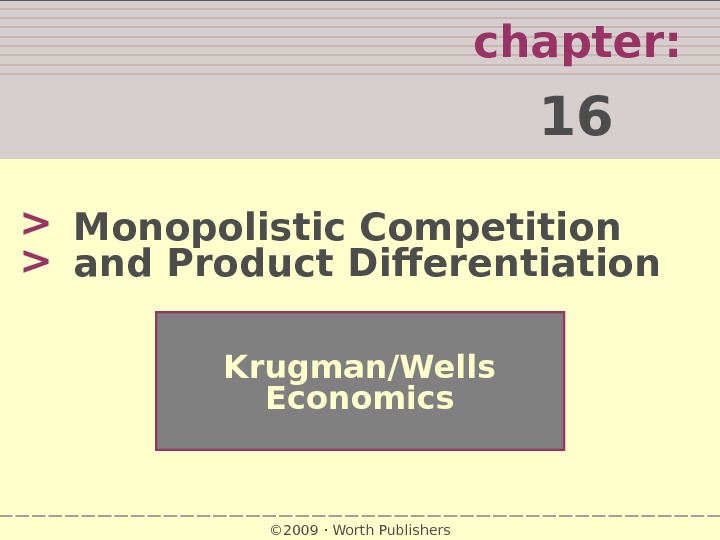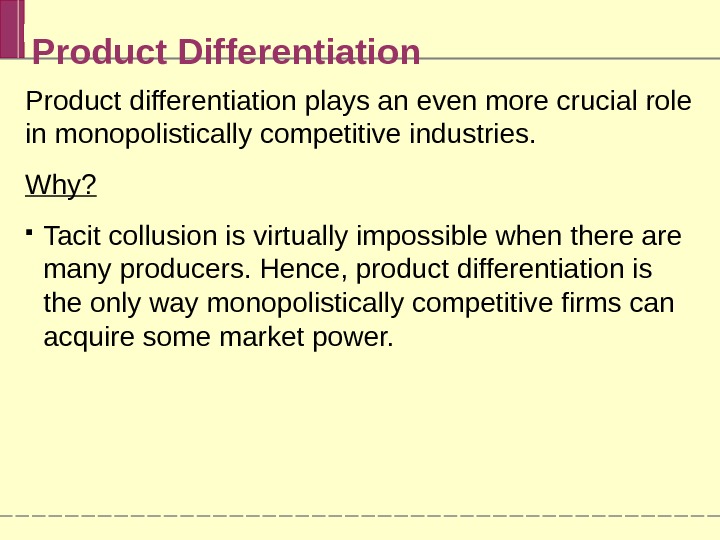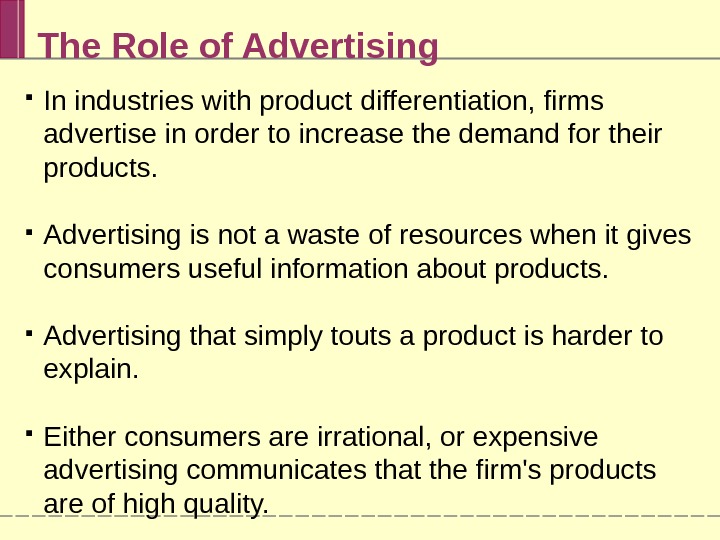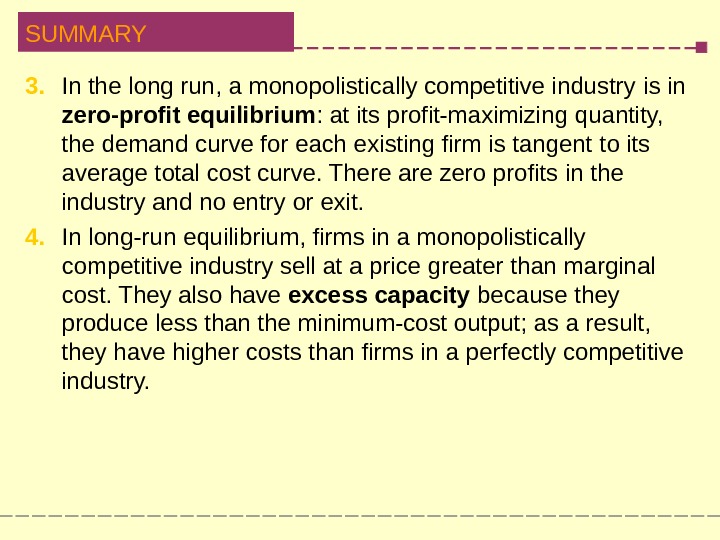WHAT YOU WILL LEARN IN THIS CHAPTER chapter:






















- Размер: 462 Кб
- Количество слайдов: 22
Описание презентации WHAT YOU WILL LEARN IN THIS CHAPTER chapter: по слайдам
 WHAT YOU WILL LEARN IN THIS CHAPTER chapter: 16 > > Krugman/Wells Economics © 2009 Worth Publishers. Monopolistic Competition and Product Differentiation
WHAT YOU WILL LEARN IN THIS CHAPTER chapter: 16 > > Krugman/Wells Economics © 2009 Worth Publishers. Monopolistic Competition and Product Differentiation
 WHAT YOU WILL LEARN IN THIS CHAPTER The meaning of monopolistic competition Why oligopolists and monopolistically-competitive firms differentiate their products How prices and profits are determined in monopolistic competition in the short run and the long run Why monopolistic competition poses a trade-off between lower prices and greater product diversity The economic significance of advertising and brand names
WHAT YOU WILL LEARN IN THIS CHAPTER The meaning of monopolistic competition Why oligopolists and monopolistically-competitive firms differentiate their products How prices and profits are determined in monopolistic competition in the short run and the long run Why monopolistic competition poses a trade-off between lower prices and greater product diversity The economic significance of advertising and brand names
 The Meaning of Monopolistic Competition Monopolistic competition is a market structure in which: there are many competing producers in an industry each producer sells a differentiated product there is free entry into and exit from the industry in the long run
The Meaning of Monopolistic Competition Monopolistic competition is a market structure in which: there are many competing producers in an industry each producer sells a differentiated product there is free entry into and exit from the industry in the long run
 Product Differentiation Product differentiation plays an even more crucial role in monopolistically competitive industries. Why? Tacit collusion is virtually impossible when there are many producers. Hence, product differentiation is the only way monopolistically competitive firms can acquire some market power.
Product Differentiation Product differentiation plays an even more crucial role in monopolistically competitive industries. Why? Tacit collusion is virtually impossible when there are many producers. Hence, product differentiation is the only way monopolistically competitive firms can acquire some market power.
 Product Differentiation How do firms in the same industry—such as fast-food vendors, gas stations, or chocolate companies—differentiate their products? Is the difference mainly in the minds of consumers or in the products themselves?
Product Differentiation How do firms in the same industry—such as fast-food vendors, gas stations, or chocolate companies—differentiate their products? Is the difference mainly in the minds of consumers or in the products themselves?
 There are three important forms of product differentiation: Differentiation by style or type – sedans vs. SUVs Differentiation by location – dry cleaner near home vs. cheaper dry cleaner far away Differentiation by quality – ordinary ($) vs. gourmet chocolate ($$$)Product Differentiation
There are three important forms of product differentiation: Differentiation by style or type – sedans vs. SUVs Differentiation by location – dry cleaner near home vs. cheaper dry cleaner far away Differentiation by quality – ordinary ($) vs. gourmet chocolate ($$$)Product Differentiation
 Product Differentiation Whatever form it takes, however, there are two important features of industries with differentiated products: Competition among sellers : Producers compete for the same market, so entry by more producers reduces the quantity each existing producer sells at any given price. Value in diversity : In addition, consumers gain from the increased diversity of products.
Product Differentiation Whatever form it takes, however, there are two important features of industries with differentiated products: Competition among sellers : Producers compete for the same market, so entry by more producers reduces the quantity each existing producer sells at any given price. Value in diversity : In addition, consumers gain from the increased diversity of products.
 Understanding Monopolistic Competition As the term monopolistic competition suggests, this market structure combines some features typical of monopoly with others typical of perfect competition: Because each firm is offering a distinct product, it is in a way like a monopolist: it faces a downward-sloping demand curve and has some market power—the ability within limits to determine the price of its product. However, unlike a pure monopolist, a monopolistically competitive firm does face competition: the amount of its product it can sell depends on the prices and products offered by other firms in the industry.
Understanding Monopolistic Competition As the term monopolistic competition suggests, this market structure combines some features typical of monopoly with others typical of perfect competition: Because each firm is offering a distinct product, it is in a way like a monopolist: it faces a downward-sloping demand curve and has some market power—the ability within limits to determine the price of its product. However, unlike a pure monopolist, a monopolistically competitive firm does face competition: the amount of its product it can sell depends on the prices and products offered by other firms in the industry.
 The MC Firm in the Short Run The following figure shows two possible situations that a typical firm in a monopolistically competitive industry might face in the short run. In each case, the firm looks like any monopolist: it faces a downward-sloping demand curve, which implies a downward-sloping marginal revenue curve. We assume that every firm has an upward-sloping marginal cost curve, but that it also faces some fixed costs, so that its average total cost curve is U-shaped.
The MC Firm in the Short Run The following figure shows two possible situations that a typical firm in a monopolistically competitive industry might face in the short run. In each case, the firm looks like any monopolist: it faces a downward-sloping demand curve, which implies a downward-sloping marginal revenue curve. We assume that every firm has an upward-sloping marginal cost curve, but that it also faces some fixed costs, so that its average total cost curve is U-shaped.
 D PProfit Loss MR P A T C(a) A Profitable Firm (b) An Unprofitable Firm Q PP P Quantity. ATC P D U MR U MC A T C Q UP U Quantity. ATC U Profit-maximizing quantity Loss-minimizing quantity. MCPrice, cost, margina l revenue Price, cost, marginal revenue. The MC Firm in the Short Run
D PProfit Loss MR P A T C(a) A Profitable Firm (b) An Unprofitable Firm Q PP P Quantity. ATC P D U MR U MC A T C Q UP U Quantity. ATC U Profit-maximizing quantity Loss-minimizing quantity. MCPrice, cost, margina l revenue Price, cost, marginal revenue. The MC Firm in the Short Run
 Monopolistic Competition in the Long Run If the typical firm earns positive profits, new firms will enter the industry in the long run, shifting each existing firm’s demand curve to the left. If the typical firm incurs losses, some existing firms will exit the industry in the long run, shifting the demand curve of each remaining firm to the right. In the long run, equilibrium of a monopolistically competitive industry, the zero-profit-equilibrium , firms just break even. The typical firm’s demand curve is just tangent to its average total cost curve at its profit-maximizing output.
Monopolistic Competition in the Long Run If the typical firm earns positive profits, new firms will enter the industry in the long run, shifting each existing firm’s demand curve to the left. If the typical firm incurs losses, some existing firms will exit the industry in the long run, shifting the demand curve of each remaining firm to the right. In the long run, equilibrium of a monopolistically competitive industry, the zero-profit-equilibrium , firms just break even. The typical firm’s demand curve is just tangent to its average total cost curve at its profit-maximizing output.
 Entry and Exit Shift Existing Firm’s Demand Curve and Marginal Revenue Curve (a) Effects of Entry (b) Effects of Exit shifts the existing firm’s demand curve and its marginal revenue curve rightward. MR 2 MR 1 D 1 D 1 D 2 D 2 Entry shifts the existing firm’s demand curve and its marginal revenue curve leftward. Price, marginal revenue Quantity
Entry and Exit Shift Existing Firm’s Demand Curve and Marginal Revenue Curve (a) Effects of Entry (b) Effects of Exit shifts the existing firm’s demand curve and its marginal revenue curve rightward. MR 2 MR 1 D 1 D 1 D 2 D 2 Entry shifts the existing firm’s demand curve and its marginal revenue curve leftward. Price, marginal revenue Quantity
 MR MC D MC MC A T C Z Q MC P MC = A T C MC Point of tangency. Price, cost, marginal revenue Quantity. The Long-Run Zero-Profit Equilibrium
MR MC D MC MC A T C Z Q MC P MC = A T C MC Point of tangency. Price, cost, marginal revenue Quantity. The Long-Run Zero-Profit Equilibrium
 Monopolistic Competition versus Perfect Competition In the long-run equilibrium of a monopolistically competitive industry, there are many firms, all earning zero profit. Price exceeds marginal cost so some mutually beneficial trades are exploited. The following figure compares the long-run equilibrium of a typical firm in a perfectly competitive industry with that of a typical firm in a monopolistically competitive industry.
Monopolistic Competition versus Perfect Competition In the long-run equilibrium of a monopolistically competitive industry, there are many firms, all earning zero profit. Price exceeds marginal cost so some mutually beneficial trades are exploited. The following figure compares the long-run equilibrium of a typical firm in a perfectly competitive industry with that of a typical firm in a monopolistically competitive industry.
 Comparing LR Equilibrium in PC and MC MC A T C (b) Long-Run Equilibrium in Monopolistic Competition MC A T C P MC = A T C MC MC MC Q PC Q MC D MCMR MCP PC = MC PC = A T C PC D = MR = P PC(a) Long-Run Equilibrium in Perfect Competition Price, cost, marginal revenue Minimum-cost output. Quantity
Comparing LR Equilibrium in PC and MC MC A T C (b) Long-Run Equilibrium in Monopolistic Competition MC A T C P MC = A T C MC MC MC Q PC Q MC D MCMR MCP PC = MC PC = A T C PC D = MR = P PC(a) Long-Run Equilibrium in Perfect Competition Price, cost, marginal revenue Minimum-cost output. Quantity
 Is Monopolistic Competition Inefficient? Firms in a monopolistically competitive industry have excess capacity : they produce less than the output at which average total cost is minimized. Price exceeds marginal cost, so some mutually beneficial trades are unexploited. The higher price consumers pay because of excess capacity is offset to some extent by the value they receive from greater diversity. Hence, it is not clear that this is actually a source of inefficiency.
Is Monopolistic Competition Inefficient? Firms in a monopolistically competitive industry have excess capacity : they produce less than the output at which average total cost is minimized. Price exceeds marginal cost, so some mutually beneficial trades are unexploited. The higher price consumers pay because of excess capacity is offset to some extent by the value they receive from greater diversity. Hence, it is not clear that this is actually a source of inefficiency.
 Controversies About Product Differentiation No discussion of product differentiation is complete without spending at least a bit of time on the two related issues: advertising brand names
Controversies About Product Differentiation No discussion of product differentiation is complete without spending at least a bit of time on the two related issues: advertising brand names
 The Role of Advertising In industries with product differentiation, firms advertise in order to increase the demand for their products. Advertising is not a waste of resources when it gives consumers useful information about products. Advertising that simply touts a product is harder to explain. Either consumers are irrational, or expensive advertising communicates that the firm’s products are of high quality.
The Role of Advertising In industries with product differentiation, firms advertise in order to increase the demand for their products. Advertising is not a waste of resources when it gives consumers useful information about products. Advertising that simply touts a product is harder to explain. Either consumers are irrational, or expensive advertising communicates that the firm’s products are of high quality.
 Brand Names Some firms create brand names. A brand name is a name owned by a particular firm that distinguishes its products from those of other firms. As with advertising, the social value of brand names can be ambiguous. The names convey real information when they assure consumers of the quality of a product.
Brand Names Some firms create brand names. A brand name is a name owned by a particular firm that distinguishes its products from those of other firms. As with advertising, the social value of brand names can be ambiguous. The names convey real information when they assure consumers of the quality of a product.
 SUMMARY 1. Monopolistic competition is a market structure in which there are many competing producers, each producing a differentiated product, and there is free entry and exit in the long run. Product differentiation takes three main forms: by style or type, by location, or by quality. 2. Short-run profits will attract entry of new firms in the long run. This reduces the quantity each existing producer sells at any given price and shifts its demand curve to the left. Short-run losses will induce exit by some firms in the long run. This shifts the demand curve of each remaining firm to the right.
SUMMARY 1. Monopolistic competition is a market structure in which there are many competing producers, each producing a differentiated product, and there is free entry and exit in the long run. Product differentiation takes three main forms: by style or type, by location, or by quality. 2. Short-run profits will attract entry of new firms in the long run. This reduces the quantity each existing producer sells at any given price and shifts its demand curve to the left. Short-run losses will induce exit by some firms in the long run. This shifts the demand curve of each remaining firm to the right.
 SUMMARY 3. In the long run, a monopolistically competitive industry is in zero-profit equilibrium : at its profit-maximizing quantity, the demand curve for each existing firm is tangent to its average total cost curve. There are zero profits in the industry and no entry or exit. 4. In long-run equilibrium, firms in a monopolistically competitive industry sell at a price greater than marginal cost. They also have excess capacity because they produce less than the minimum-cost output; as a result, they have higher costs than firms in a perfectly competitive industry.
SUMMARY 3. In the long run, a monopolistically competitive industry is in zero-profit equilibrium : at its profit-maximizing quantity, the demand curve for each existing firm is tangent to its average total cost curve. There are zero profits in the industry and no entry or exit. 4. In long-run equilibrium, firms in a monopolistically competitive industry sell at a price greater than marginal cost. They also have excess capacity because they produce less than the minimum-cost output; as a result, they have higher costs than firms in a perfectly competitive industry.
 SUMMARY 5. A monopolistically competitive firm will always prefer to make an additional sale at the going price, so it will engage in advertising to increase demand for its product and enhance its market power. Advertising and brand names that provide useful information to consumers are economically valuable. But they are economically wasteful when their only purpose is to create market power. In reality, advertising and brand names are likely to be some of both: economically valuable and economically wasteful.
SUMMARY 5. A monopolistically competitive firm will always prefer to make an additional sale at the going price, so it will engage in advertising to increase demand for its product and enhance its market power. Advertising and brand names that provide useful information to consumers are economically valuable. But they are economically wasteful when their only purpose is to create market power. In reality, advertising and brand names are likely to be some of both: economically valuable and economically wasteful.
